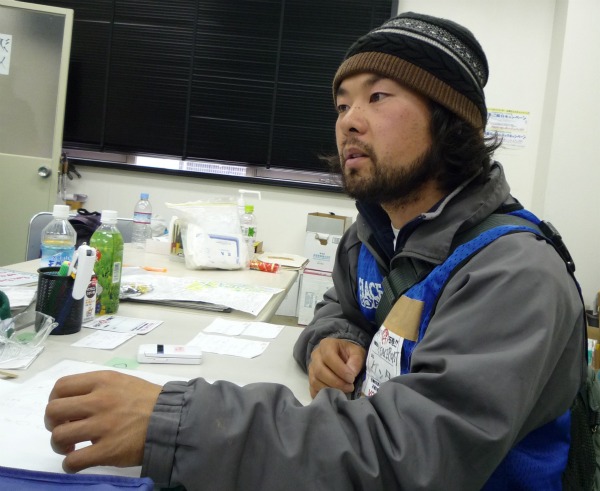
Activity Reports
Volunteer interview – Torii Kenta
May 17, 2011
“I wanted to see what was happening in the area, that was all,” says Peace Boat volunteer Torii Kenta about his initial motivation.
A seasoned backpacker and traveller, Kenta is used to camping out and preparing his own meals in the outdoors. He went to the affected areas as an individual volunteer for a 5 day and a 3 day stay initially, mainly working with sludge and debris removal.
Individual volunteers who are working as part of any NGO or relief organization will show up daily at the local Social Welfare Committee office to volunteer themselves for the days assignment. Waiting around for long periods of time for the days assignment is all part and parcel of the daily life of an individual volunteer. Kenta found himself wanting to volunteer over a longer period of time so that he could focus his energies more clearly on required relief efforts. He started looking for organizations based locally, and found Peace Boat.
Kenta joined the Peace Boat group dispatched to Ishinomaki on April 8. He initially stayed for 3 weeks and found that the area around Ishinomaki train station showed a marked improvement over that time. His faith in volunteerism and the relevance of working there was reaffirmed. He deduces that the factors contributing to this are the increasing number of volunteers and also the fact that many volunteers are staying for longer periods and gaining mastery over the content of their tasks. The whole effort is speeding up and increasing in scope. “I thought the power of human strength is not be laughed at,” he says optimistically.
Meetings are held every morning with the local authorities as well. The organized approach is another contributing factor to the smooth relief operations. Local authorities will instruct volunteers and organizations on which areas/houses/buildings should be worked on that day.
Modern technology is also proving to be a useful tool in relief efforts. Kenta is a twitter user who gained contact with a local Ishinomaki business proprietor, who then asked him for clean-up help via the global social networking site. He brought this plea to the attention of the person in charge of the area in the local administration, who then sent out a team of volunteers to the business in question.
A “connection” between people. Kenta has been feeling this very strongly since he started his volunteering efforts. “I will be going back to my home town of Nagoya soon. However the connections I made with people here in Ishinomaki will continue. I will be coming back periodically to volunteer. I feel like in some ways, I gained a new home.”

Peace Boat Volunteer Torii Kenta



